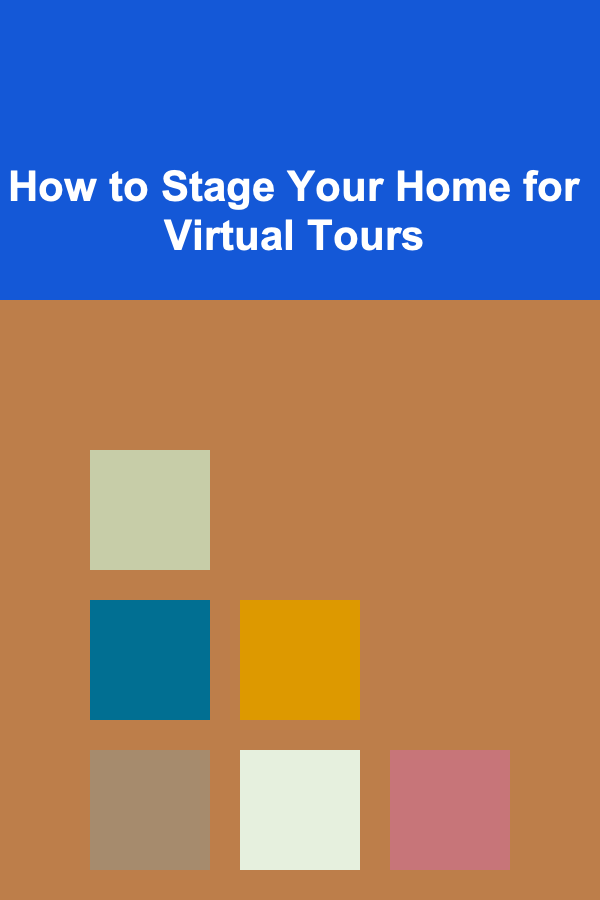
How to Stage Your Home for Virtual Tours
ebook include PDF & Audio bundle (Micro Guide)
$12.99$6.99
Limited Time Offer! Order within the next:

In today's real estate market, virtual tours have become an essential tool for sellers and agents alike. Virtual home tours allow prospective buyers to view a property remotely, offering convenience and flexibility without the need for in-person visits. As more buyers turn to digital platforms to search for homes, it's crucial for sellers to ensure their homes are presented in the best light possible during these virtual showings. This article will provide in-depth advice on how to stage your home for virtual tours, from the basics to advanced techniques that will help make your home stand out in the digital marketplace.
Understanding Virtual Tours
Before diving into the specifics of home staging for virtual tours, it's important to understand what a virtual tour is and how it works. Virtual tours are digital representations of a property that allow potential buyers to explore a home remotely. These tours can be 360-degree images, videos, or even interactive walkthroughs, often supported by a real estate website or a third-party platform.
Unlike traditional photographs, virtual tours give potential buyers the opportunity to experience the flow of a home and get a feel for its layout. This immersive experience is often the first point of contact for many buyers and can influence their decision to move forward with a showing or make an offer.
The Importance of Staging for Virtual Tours
Staging a home for a virtual tour is just as important as staging it for an in-person viewing. A well-staged home can make a strong first impression, highlighting its best features and allowing potential buyers to envision themselves living in the space. A cluttered or poorly presented home can have the opposite effect, potentially discouraging buyers from pursuing the property further.
Effective staging for virtual tours involves more than just making a home look pretty on camera. It's about creating a welcoming, spacious, and functional environment that translates well to the digital medium. A staged home for virtual tours should appeal to the emotions and imaginations of buyers, even though they are not physically present in the space.
Key Considerations for Staging Your Home for Virtual Tours
Staging for virtual tours is different from staging for traditional open houses. It's essential to keep in mind the visual aspect of virtual tours, as these are viewed through screens. Lighting, camera angles, and room layout play a significant role in how the space is perceived.
Here are several key considerations for staging your home for virtual tours:
1. Lighting is Key
Good lighting is essential for any virtual tour. Without proper lighting, the home can look dark, uninviting, or even unclean. Buyers may be turned off by poorly lit spaces, as they are harder to appreciate on camera. Consider these lighting tips:
- Maximize natural light: Open the blinds and curtains to let as much natural light into the space as possible. Bright rooms are more appealing in photos and virtual tours.
- Use artificial lighting strategically: If natural light is limited, make sure to use artificial lighting to brighten dark corners and rooms. Place lamps in key areas, such as beside the sofa, in entryways, and in the kitchen.
- Avoid harsh overhead lighting: Ceiling lights can cast unflattering shadows. Use soft, warm lighting to create a cozy and inviting atmosphere.
- Highlight key features: Use lighting to highlight architectural features, such as fireplaces, accent walls, or custom-built shelving, which can make a big impression in a virtual tour.
2. Declutter and Simplify
When preparing your home for a virtual tour, decluttering is essential. Clutter can distract buyers from the key features of your home and make spaces look smaller or less inviting. For a virtual tour, where potential buyers are unable to physically walk through and touch things, the importance of a tidy, clean space cannot be overstated. Consider these tips to declutter and simplify your home:
- Remove personal items: Family photos, excessive knick-knacks, and personal items should be taken down or hidden away. Buyers want to envision themselves in the space, and having personal items on display can prevent them from imagining their own belongings in the home.
- Minimize furniture: Too much furniture can make a space appear cramped. Aim to have just the essentials in each room. If necessary, temporarily remove furniture pieces to create more open space.
- Organize storage areas: Don't just focus on the visible areas of your home---ensure that closets, cabinets, and storage spaces are neatly organized as well. Buyers may want to see these areas during a virtual tour, and showing them in disarray can send the wrong message.
3. Maximize Space and Flow
Space and flow are two critical elements to consider when staging a home for virtual tours. When buyers view your home online, they need to get a sense of how spacious the rooms are and how they flow into one another. Virtual tours should allow potential buyers to imagine themselves walking through the home, so it's important that the space feels open, functional, and connected.
- Create clear pathways: Make sure that furniture is arranged to create a natural flow of movement between rooms. Avoid blocking walkways or creating obstacles that could make the space feel cramped or awkward.
- Use mirrors strategically: Mirrors can make a room appear larger and more open. Place mirrors in strategic locations to reflect light and enhance the feeling of space.
- Keep furniture proportions in check: Be mindful of the size of your furniture. Large, bulky pieces can overwhelm a room, while appropriately scaled furniture can create the illusion of a larger space.
4. Use Color Wisely
The colors in your home can have a significant impact on how it's perceived in a virtual tour. While bold, vibrant colors may be appealing to some, neutral and soft tones tend to photograph better and create a more universally appealing atmosphere. When staging your home for a virtual tour, consider the following:
- Neutral tones for the win: Soft grays, whites, beige, and other neutral tones are often the best choice for virtual tours, as they create a calm and inviting atmosphere. These colors also help potential buyers focus on the space itself rather than being distracted by the color of the walls.
- Add pops of color carefully: If you want to add color to your home, do so sparingly. Accent pillows, artwork, and rugs in shades of blue, green, or yellow can add visual interest and warmth, but keep them balanced with neutral tones.
- Highlight architectural features: If your home has any standout architectural features, such as crown molding, wainscoting, or an impressive fireplace, make sure the color scheme complements and enhances these features.
5. Highlight Key Selling Points
Every home has features that make it stand out. Whether it's a spacious kitchen, an inviting master bedroom, or an outdoor patio, it's important to highlight these selling points during a virtual tour. Here's how to ensure that your home's best features get the attention they deserve:
- Focus on focal points: If your home has unique features, such as a beautiful fireplace, a stunning view, or custom cabinetry, make sure they are highlighted during the virtual tour. Consider using lighting or arranging furniture to draw attention to these areas.
- Stage rooms appropriately: Make sure each room is staged according to its intended use. A living room should look comfortable and inviting, while a home office should look functional and organized. The staging should highlight the room's potential and convey its purpose clearly.
6. Create a Welcoming Atmosphere
Even though potential buyers are viewing your home remotely, it's important to create a sense of warmth and hospitality. A welcoming atmosphere can help buyers feel comfortable and draw them into the space, making them more likely to take the next step in the buying process.
- Use soft textiles: Soft, cozy textiles like plush throw blankets, pillows, and area rugs can add warmth and texture to a room. This is especially important for virtual tours, where textures may not be felt but can still be visually appreciated.
- Add fresh touches: Fresh flowers, potted plants, or fresh fruit can make a home feel inviting and lived-in. These small touches add personality and charm, helping buyers imagine the home as a place they want to live.
- Set the mood with scents: While scents won't translate in a virtual tour, you can still ensure that your home smells inviting when buyers come for an in-person tour. Light a candle, use essential oils, or bake cookies right before a scheduled showing to create a welcoming scent.
7. Consider Professional Help
While staging a home for a virtual tour is certainly something you can do on your own, hiring a professional can make a significant difference, especially if you're aiming to sell your home quickly or at a high price. A professional stager has the experience and expertise to know exactly what buyers are looking for and can stage your home in a way that maximizes its appeal in a virtual setting.
Additionally, a real estate agent can often help with the technical side of the virtual tour. Whether it's arranging for a photographer who specializes in virtual tours or helping you with the best platforms for showcasing your property online, professional assistance can help ensure that your home is presented in the best possible way.
Conclusion
Staging your home for virtual tours is an essential step in showcasing your property to potential buyers. By maximizing lighting, decluttering, enhancing space and flow, and highlighting key features, you can create a welcoming, spacious environment that appeals to remote buyers. Keep in mind that the goal is to help buyers envision themselves in the space, and by focusing on these key staging principles, you can ensure your home stands out in a crowded digital marketplace.
As the real estate world continues to embrace digital solutions, perfecting your virtual home staging skills will be essential for a successful sale. Whether you're selling a single-family home, a condo, or a luxury estate, presenting your property through an engaging and professionally staged virtual tour can make all the difference in attracting serious buyers and closing a deal.
Reading More From Our Other Websites
- [Home Budget Decorating 101] How to Mix High and Low for a Chic Home Design on a Budget
- [Personal Care Tips 101] How to Find the Best Face Oil for Mature Skin
- [Home Maintenance 101] How to Organize Appliance Manuals and Warranties
- [Organization Tip 101] How to Incorporate Toy Organization into Daily Routines
- [Paragliding Tip 101] From Beginner to Pro: Choosing the Right Wing for Optimal Flight Performance
- [Personal Finance Management 101] How to Use the Best Debt and Budget App to Manage Your Finances
- [Tiny Home Living Tip 101] How to Host Intimate Gatherings in a Tiny Home Without Feeling Cramped
- [Simple Life Tip 101] How to Create a Peaceful Bedroom Sanctuary Using Minimalist Design Principles
- [Home Budget Decorating 101] How to Add Stylish Accent Walls with a Tight Budget
- [Home Rental Property 101] How to Handle Tenant Security Deposits Legally and Fairly

How to Declutter Your Digital Devices for Better Focus
Read More
How to Incorporate Technology into Your Personal Library
Read More
How to Save Money with DIY Clothing Alterations and Repairs at Home
Read More
How to Master Campfire Cooking
Read More
How To Develop a Strong Sense of Self-Worth
Read More
How to Create the Ultimate Outdoor Movie Night Experience
Read MoreOther Products

How to Declutter Your Digital Devices for Better Focus
Read More
How to Incorporate Technology into Your Personal Library
Read More
How to Save Money with DIY Clothing Alterations and Repairs at Home
Read More
How to Master Campfire Cooking
Read More
How To Develop a Strong Sense of Self-Worth
Read More